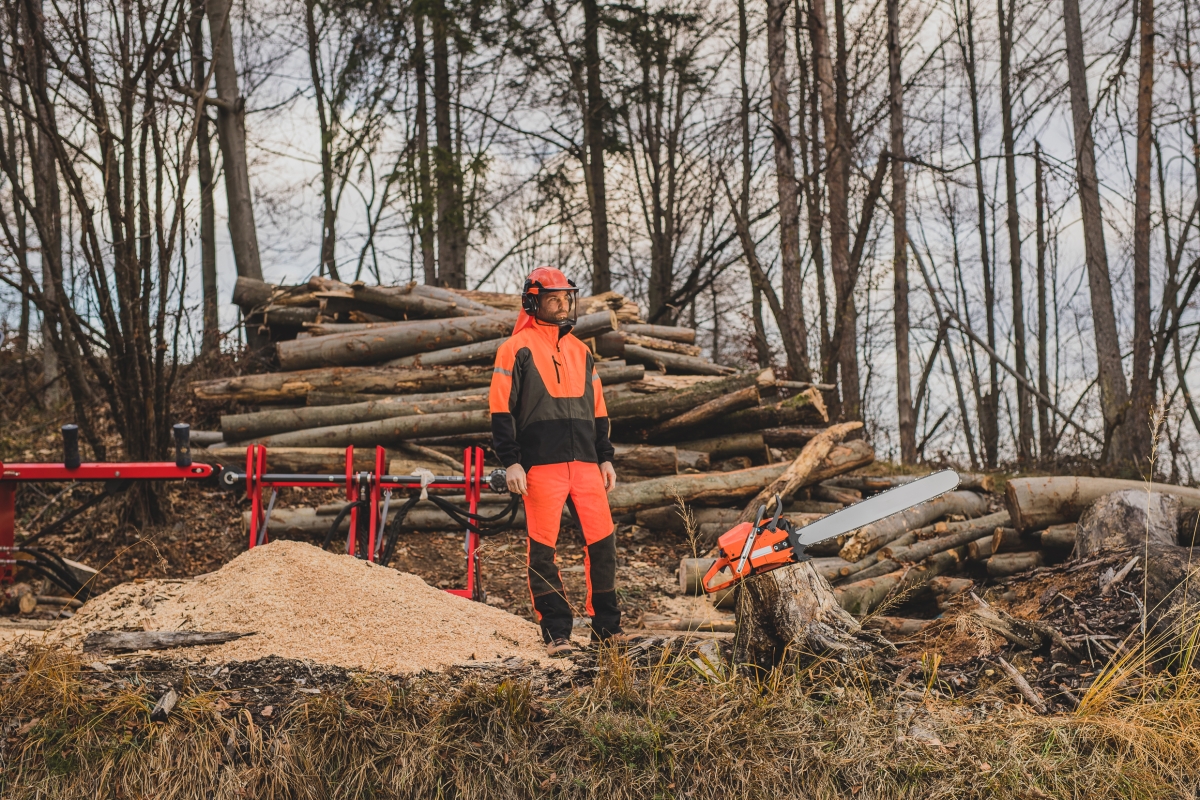Career Overview
People in this occupation:
- Operate cable yarding systems, mechanical harvesters and forwarders and mechanical tree processors and loaders to fall, yard and process trees at logging sites
- Work for logging companies and contractors
- Should be physically fit and enjoy working outdoors and in remote settings
- Should also have a strong mechanical ability since they often work with and maintain machinery
- Must be comfortable working in a team setting
- Should have knowledge of safety procedures due to hazardous working conditions
Job Titles
Duties
In general, workers in this group operate machines to harvest, transport and process timber. Specific duties depend on the type of machinery used. The following descriptions are typical for a large logging operation. Within smaller logging operations, a worker might perform several or all of these duties.
Mechanical harvester and forwarder operators:
- Evaluate logging sites and terrain prior to logging
- Use various heavy equipment to fall (cut down trees) and delimb (remove branches)
- Cut logs into specific lengths, which are sent to a collection point (forwarding) where they are bundled and loaded on a truck to be sent for further processing
Mechanical tree processors and operators:
- Use machines for the same operations as mechanical harvester and forwarder operators (except falling) at landing sites
Cable yarding operators:
- Use machines, steel cables and chains to transport logs after they have been felled and prepared by rigging slingers
- Use an array of cable yarding techniques
Earnings
Earnings is income that workers receive in exchange for their labour. Depending on the type of employment, earnings can be in the form of wages (hourly), salaries (fixed monthly or annual) or self-employed earnings.
Work Environment
# Workers Employed
1,565% Employed Full Time
42%Workers in this group work outdoors and are subject to a variety of weather conditions. Work environments can be challenging since conditions often include loud machinery, unstable ground and steep slopes. Hazards such as trees falling and cables snapping are also present. All work sites make safety the number one priority and follow strict safety regulations to reduce risks of such hazards.
Most workers in these occupations work full time, however, most work is generally done during winter months when logging typically takes place. As a result, these workers are not typically employed throughout the full year. Seasonal work can vary depending on the location of the work (i.e., coastal versus interior regions).
Shifts vary from 8–12 hours depending on the worker's position and the location of the work. Longer shifts are more common in logging camps as well as in the northern and interior parts of the province where there are less operating days in a year. Overtime is more common in logging camps. Rotating shift work is also common. Operators typically work 40–50 hours per week.
Since job sites are often located in remote areas, workers may be required to travel and remain on site for extended periods of time.
Career Pathways
Workers in this occupational group can progress to more advanced machinery operating positions with experience. Promotion to logging and forestry supervisory positions is also possible but rare.
Some workers may purchase their own equipment and operate as contractors.
Occupational Interests
It’s important to understand what kinds of occupations align with your interests.
For more about occupational interests visit Skills for the Future Workforce > Characteristics.
Here are the top occupational interest(s) for this career profile:
Education, Training and Skills
Completion of secondary school may be required to work in this profession. On-the-job training is provided and is typically three to 16 months long, depending on the type of machinery used. Other training and requirements may include:
- An understanding of tree harvesting regulations
- Experience in various positions in the logging industry, however, the level required varies by occupation
- Heavy equipment operator certification, air brake certification, Workplace Hazardous Materials Information System certification and first aid certification
- Training or knowledge of basic machine maintenance particularly related to machine hydraulic systems
- Mechanical harvester and forwarder operators may require logging experience as a chain saw and skidder operator
- Feller buncher operators and cable yarder operators usually require three to five years of logging experience
- Mechanical tree processor and loader operators usually require one to three years of logging experience
The Safety Accord Forest Enterprise (SAFE) Companies program, requiring forest companies in B.C. to be safety certified, is leading towards the development of standardized training for logging equipment operators. Certification through training will be required for all logging equipment operators B.C. in the near future, as it currently is a requirement for fallers.
Education programs in B.C.

Top Skills
Every job calls for a certain set of skills. Knowing those skills is the first step in finding a good career fit.
Here, you will find the 10 most relevant workplace skills. Some are more important to achieving success in a certain career than others. These skills may come naturally to you or you may need to gain them through education, training and experience.
See the list of work-related skills below, ranked in order of importance for this career. Check out the list and see if this career matches your skills—take that first step!
Controlling operations of equipment or systems.
Watching gauges, dials or other indicators to make sure that a machine is working properly.
Performing routine maintenance on equipment and determining when and what kind of maintenance is needed.
Keeping track of and assessing your performance, other individuals, or organizations to make improvements or take corrective action.
Conducting tests and inspections of products, services or processes to evaluate quality or performance.
Determining causes of operating errors and deciding what to do about it.
Giving full attention to what other people are saying, taking time to understand the points being made, asking questions as appropriate, and not interrupting at inappropriate times.
Repairing machines or systems using the needed tools.
Using logic and reasoning to identify the strengths and weaknesses of alternative solutions, conclusions or approaches to problems.
Managing one’s own time and the time of others.
Labour Market Statistics
Discover data, facts and information that have been gathered and analyzed. Learn about the characteristics of the economy and labour market in B.C.
Employment
Find out about employment types and trends by region and industry.
Employment
1,565Employment by Region







| Region | Employment | % Employment of this Occupation |
|---|---|---|
| Cariboo | 190 | 12.1% |
| Kootenay | 185 | 11.8% |
| Mainland/Southwest | 135 | 8.6% |
| North Coast and Nechako | 190 | 12.1% |
| Northeast | 65 | 4.2% |
| Thompson-Okanagan | 255 | 16.3% |
| Vancouver Island/Coast | 545 | 34.8% |
Labour Market Outlook
The B.C. Labour Market Outlook is a 10-year forecast of the expected supply and demand for labour in the province. It’s usually updated every year. The purpose is to provide British Columbians with the knowledge to make informed decisions on careers, skills training, education and hiring.
Forecasted Job Openings (2025-2035)
520Forecasted Job Openings
Forecasted Employment Growth Rate
Composition of Job Openings
Job Openings by Region (2025-2035)







| Region | Job Openings | Avg. Annual Employment Growth |
|---|---|---|
| Cariboo | 50 | 0.0% |
| Kootenay | 50 | -0.2% |
| Mainland/Southwest | 40 | -0.1% |
| North Coast and Nechako | 80 | 1.2% |
| Northeast | 10 | -1.1% |
| Thompson-Okanagan | 70 | 0.0% |
| Vancouver Island/Coast | 230 | 0.8% |
Industry Highlights
Learn about the opportunities in B.C.'s major industries, including employment trends, earning potential, locations of work and more.
Forecasted Job Openings by Industry
| Industry | Job Openings (2025-2035) |
|---|---|
| Forestry, Logging and Support Activities | 470 |
| Manufacturing | 40 |
| Agriculture and Fishing | 10 |
| Construction | 10 |
Insights from Industry
Employment in the forestry sector was hit hard by the world recession in general, as well as by the collapse of American home building. It reached record lows in 2008 and 2009, with work in the sector nearly 8,000 jobs less than in the previous five years. Labour market conditions for the industry are expected to recoup lost ground in the coming years as the economic recovery strengthens and U.S. home construction increases.
In the short term, new jobs will be created in B.C. in response to the need to harvest pine beetle damaged wood. There may continue to be activity in B.C.'s interior after the pine beetle problem has been taken care of. Other species of timber that are ready to be harvested have been left untouched since most resources have gone towards solving the pine beetle problem.
Also, as the economy recovers, good opportunities for job seekers will continue due to the limited number of experienced workers available to fill openings that arise from job growth and retirements.
Across B.C. high retirement rates and the inability of most firms to recruit and retain young workers to replace retirees are contributing to a labour shortage in this occupation. Many experienced machine operators have left the forest sector to seek work in the Mining and Oil and Gas industries, which previously offered more consistent work and similar pay. In addition, most new, young workers interested in machine operation also looked for work in the Mining, and Oil and Gas industries for similar reasons.
Negative public perceptions of the forest sector and the unwillingness of many young people to live outside of urban centers is also making it difficult for logging companies to find new workers. This problem is expected to worsen over the next five to 10 years as more workers retire.
Advances in technology will negatively affect demand for some forestry occupations, as they allow more work to be completed with fewer workers. The use of more advanced equipment and mechanization will continue to result in the elimination of some entry level positions and a need for more skilled workers.
Resources
-
B.C. Ministry of Forests, Lands, Natural Resource Operations and Rural Developmentwww.gov.bc.ca/forests
-
British Columbia Forest Safety Council (BCFSC)www.bcforestsafe.org
-
Council of Forest Industries (COFI)www.cofi.org
-
Forest Practices Boardwww.bcfpb.ca
-
Forestry Innovation Investment (FII)www.bcfii.ca
-
Truck Loggers Association (TLA)www.tla.ca







